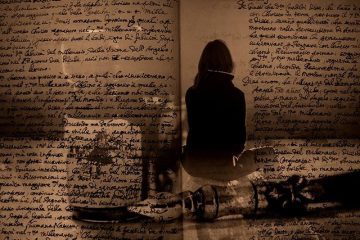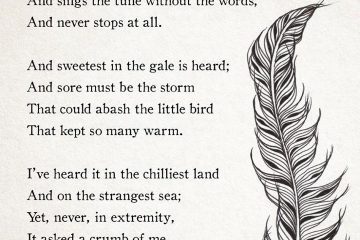Table of Contents
- Understanding the Essence of an Eight-Line Poem
- Crafting Concise Imagery and Emotion
- Exploring Famous Eight-Line Poems in Literature
- Tips for Writing Impactful Eight-Line Poems
- The Role of Structure and Rhyme in Short Poetry
- Q&A
- To Conclude


Understanding the Essence of an Eight-Line Poem
An eight-line poem offers a unique format that combines brevity with the opportunity for depth and creativity. Often referred to as “octet” or simply “eight-liner,” this type of poem challenges the poet to convey thoughts, emotions, or narratives within a limited space, making every word count. The constraints of an eight-line structure encourage poets to play with form, rhythm, and rhyme, resulting in pieces that can be both impactful and memorable. In this concise framework, traditional patterns, such as ABAB or AABB, are commonly employed, while some poets opt for free verse to break conventions.
Writing an eight-line poem demands skillful word choice and a clear focus. Poets frequently build these poems around a central image or idea, exploring a mood or sensation with precision. Emotional intensity can be heightened in such a condensed form, as each line becomes a vital component in expressing the overall theme. Here are a few techniques that poets might use to enhance the impact of their work:
- Imagery: Use vivid descriptions to paint a picture in the reader’s mind.
- Metaphor: Employ powerful symbols or analogies to convey deeper meanings.
- Rhyme and Meter: Introduce patterns that create a musical quality.
Despite its simplicity, an eight-line poem offers a vast range of expression, from the deeply personal to the universally relatable. It can serve as a standalone piece or as part of a larger collection, such as the opening stanza of a sonnet. The versatility of this form also makes it ideal for experimentation, whether through playing with syntax or incorporating modern themes. The brief length invites readers to pause and reflect, engaging with the text on a more intimate level. This balance between constraint and creativity is what gives the eight-line poem its enduring charm.


Crafting Concise Imagery and Emotion
- Imagery in poetry is the delicate art of painting pictures with words, where each line is a brushstroke that evokes vivid scenes or emotions. A well-crafted poem uses this tool to transport readers to worlds unseen, making them feel as if they stand in the midst of a misty dawn or under a harsh midday sun. The art lies in selecting potent words that project clarity and depth within the confines of a mere eight lines.
Emotion is the heartbeat of poetry, a driving force that transforms simple descriptions into deeply resonant experiences. In crafting brief poetry, writers weave emotion through visual, auditory, and sensory imagery, creating a symbiosis of feeling and vision. Consider the impact of words like “whisper” versus “shout”—each carries unique emotional weight, inviting readers to feel the poem’s pulse through their interpretations. This emotional infusion ensures that even the shortest poems linger in the memory, compelling readers to relive them repeatedly.
| Imagery | Emotional Impact |
|---|---|
| Vast blue skies | Serenity |
| Silent snowfall | Nostalgia |
| Roaring seas | Adventure |
To encapsulate a universe of beauty or a storm of emotion within a limited framework tests both brevity and imagination. Such poems demand precision, where every syllable contributes meaning and enhances the narrative. Through clever wordplay or striking metaphors, poets achieve this economy of language, refining their message to its essence. This practice not only empowers the written word but also honors the reader’s imagination, inviting them to fill spaces with personal interpretations and emotional truths.


Exploring Famous Eight-Line Poems in Literature
- One of the most celebrated eight-line poems in literature is Emily Dickinson’s untitled piece often referred to by its first line, “Ample make this bed.” Its concise structure captures the essence of her signature style—minimalist yet profound. The poem’s tightly woven stanzas explore themes of rest and eternity, inviting readers to ponder the deeper meaning of life’s final repose. Dickinson’s ability to convey such evocative imagery within just a few lines demonstrates her mastery over brevity and depth.
- Robert Frost’s “Dust of Snow” is another exquisite example of an impactful eight-line poem. Through simple yet vivid imagery, Frost transforms an ordinary winter’s moment into a reflection on life’s unexpected joys and transformations. This piece, packed with symbolism, underscores how small encounters with nature can profoundly alter one’s mood and perspective. Its economy of words captures the heart of Frost’s poetic soul, delivering a compelling narrative within a concise form.
| Poem | Theme | Impact |
|---|---|---|
| Emily Dickinson’s “Ample make this bed” | Eternity & Rest | Elegance in brevity |
| Robert Frost’s “Dust of Snow” | Transformation & Nature | Uplifting observations |
W.H. Auden’s “Funeral Blues” also includes an evocative segment that, when excerpted into an eight-line passage, delivers a powerful emotional impact. Known for its expressive exploration of grief and mourning, Auden’s work delves into universal themes of loss and despair. The use of stark imagery combined with rhythmic composition creates a poignant, memorable experience. Like many exemplary short poems, this excerpt achieves an intense connection with readers, illustrating how a few select lines can resonate profoundly, echoing emotions and experiences universally felt.
Tips for Writing Impactful Eight-Line Poems
- Choose a Strong Theme: Start by selecting a theme that resonates with you personally or has the potential to engage others. Whether it’s love, nature, or a moment in time, be sure to explore it deeply enough to convey powerful emotions and vivid imagery. A unified theme ensures coherency, making each line purposeful and interconnected, helping readers find deeper meanings within your words.
Delve into the power of concise language. With only eight lines, every word must count. Employ compact phrases that capture the essence of your theme in alignment with evocative imagery. Use literary devices like personification or metaphors to add layers of meaning without adding extra bulk. This way, every line becomes an anchor, holding a significant narrative weight and allowing readers to engage with both the literal and the symbolic.
| Element | Impact |
|---|---|
| Alliteration | Enhances rhythm |
| Assonance | Creates mood and tone |
| Imagery | Evokes vivid pictures |
Experiment with structure by varying your use of stanza formats and rhyme schemes. While traditional forms can guide the rhythm and flow, breaking formal boundaries can lead to exciting discoveries. Consider alternating rhymes (ABAB) or couplets (AABB) to bring musicality into your poem. Additionally, balance the ebb and flow of syllables to maintain a smooth cadence, ultimately drawing the reader into the world you’ve created.


The Role of Structure and Rhyme in Short Poetry
In the realm of short poetry, structure and rhyme play pivotal roles in creating impact within a condensed form. The framework of an eight-line poem allows the poet to experiment with form, from classic rhyme schemes such as ABAB or AABB to more modern and free-flowing styles. This concise structure demands precision and creativity, urging poets to extract the essence of their emotions and thoughts.
- Structural Benefits:
- Enhances brevity and clarity
- Provides a rhythmic cadence
- Facilitates memorable expressions
- Rhyme Advantages:
- Creates pleasing auditory effects
- Links ideas and themes
- Increases engagement
| Structure Type | Rhyme Scheme | Characteristics |
|---|---|---|
| Quatrain | AABB | Simplicity and harmony |
| Sonnet | ABAB | Complexity and depth |
No matter the choice of rhyme or structure, these elements serve to enhance the narrative of the poem, making every word count. Whether through the predictable charm of a traditional scheme or the surprise of a less conventional one, the interplay of rhyme and structure in short poetry acts as a catalyst for creativity, coaxing out meaning and emotion within limited lines.
Q&A
Q1: What is the significance of an 8-line poem?An 8-line poem, often referred to as an octet or octave, holds a unique charm due to its brevity and ability to convey profound emotions or ideas within a limited structure. This constraint challenges poets to be concise and creative, making each word carry weight and meaning. The octet format is versatile, suitable for expressing a complete thought, introducing a concept, or creating a vivid image.Q2: Can you provide examples of famous 8-line poems?Certainly! One example is William Butler Yeats’ “The Balloon of the Mind,” which vividly captures the struggle and artistry of a poet’s imagination. Another example is “The Rose” by William Carlos Williams, known for its sharp imagery and simplicity. These poems demonstrate how the octet format can succinctly deliver powerful messages.
Q3: How does the structure of an 8-line poem influence its content?The structure of an 8-line poem inherently demands focus and economy in language. Poets must distill their thoughts to fit the format, often leading to intense imagery and concentrated emotions. The limited length encourages the use of poetic devices like rhyme, meter, and metaphor to enhance depth and resonance. This structure can make the poem feel complete and impactful despite its brevity.
Q4: Are there specific themes commonly explored in 8-line poems?While 8-line poems can explore a wide range of themes, they often delve into topics like nature, love, introspection, and fleeting moments. The brevity of the form lends itself well to capturing intense emotions or creating vivid snapshots. These poems often reflect personal insights or universal truths, allowing readers to resonate with the concise expression of the poet’s thoughts.
Q5: How can one start writing an 8-line poem?To begin writing an 8-line poem, start by choosing a theme or emotion you want to explore. Consider the essence of what you want to convey and how it can be distilled into eight impactful lines. Use vivid imagery and poetic devices to enhance your message. Remember, the key is to focus on clarity and expression, allowing each line to contribute meaningfully to the overall composition. Experiment with different styles, such as rhymed or free verse, to find what best suits your voice.




0 Comments